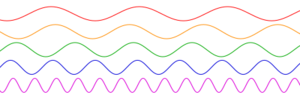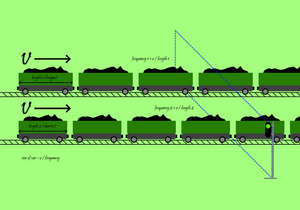Frequency facts for kids
Frequency is how often something happens or repeats itself over a set amount of time. Imagine a clock ticking; its ticks have a certain frequency. Or think about your favorite song; the sound waves that make up the music have different frequencies.
In physics, especially when we talk about waves, frequency tells us how many wave peaks (or "crests") pass by a specific point in just one second.
The unit for measuring frequency is called the Hertz (Hz). If something has a frequency of 1 Hertz, it means it happens once per second. If it's 100 Hz, it happens 100 times per second!
Contents
How Waves, Speed, and Frequency Connect
There's a cool connection between a wave's frequency, its speed, and its wavelength (the distance between two peaks). This relationship is shown by a formula:

In this formula:
- f stands for frequency.
- v stands for the wave's speed.
 (pronounced "lambda") stands for the wavelength. This is the length of one complete wave.
(pronounced "lambda") stands for the wavelength. This is the length of one complete wave.
For light waves, the formula is a bit special:  . Here, c is the speed of light, which is super fast!
. Here, c is the speed of light, which is super fast!
Different Types of Waves
All electromagnetic waves travel at the speed of light when they are in a vacuum (like space). However, they slow down when they travel through other materials, like air or water.
Examples of electromagnetic waves include:
- Light waves (what we see)
- Radio waves (used for communication)
- Infrared radiation (heat from a remote control)
- Microwaves (used in ovens)
- Gamma waves (powerful rays from space)
Other waves, like sound waves, travel much slower than light. They also cannot travel through a vacuum, which is why you can't hear sounds in space!
Visualizing Frequency with Trains
Let's imagine two different trains traveling at the exact same speed. One train has very small cars, and the other has much larger cars.
Counting Train Cars
Imagine you are standing next to the tracks, holding a signpost. You decide to count how many train cars pass your signpost in one second for each train.
- For the train with smaller cars, many more cars would pass your signpost in one second. This means it has a higher "frequency" of cars passing.
- For the train with larger cars, fewer cars would pass in one second. This means it has a lower "frequency" of cars passing.
Finding the Car Length
Knowing the train's speed and the frequency of cars passing, you could figure out the length of each train car.
For example:
- If a train moves at 10 miles per second, and 10 train cars pass in one second, then each car must be 1 mile long (10 miles/second divided by 10 cars/second = 1 mile/car).
- If another train also moves at 10 miles per second, but 20 train cars pass in one second, then each car is only 0.5 miles long (10 miles/second divided by 20 cars/second = 0.5 miles/car).
This example shows how knowing the frequency of an electromagnetic wave helps you find its wavelength. Since all electromagnetic waves travel at the speed of light (c), if you know the frequency (f), you can find the wavelength (lambda) using the formula: wavelength = c / frequency.
Images for kids
-
A pendulum that swings back and forth about 0.36 times per second.
See also
 In Spanish: Frecuencia para niños
In Spanish: Frecuencia para niños






